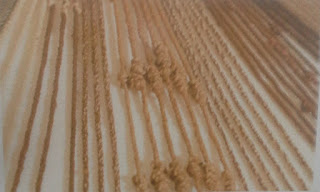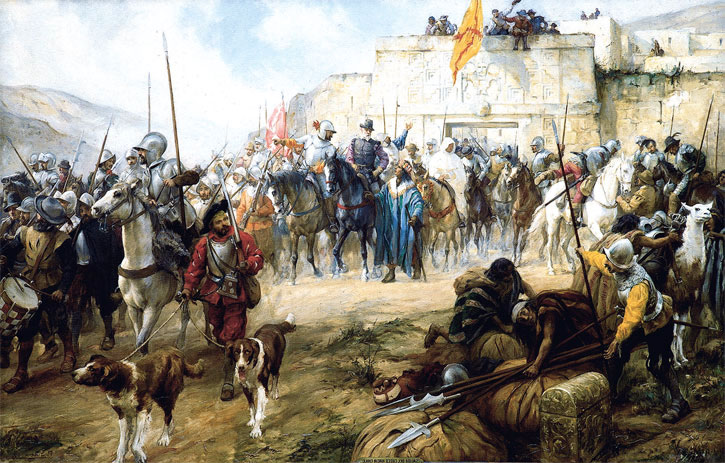Fashion Book Friday: El hilo conductor. Tradición y moda en el Perú (The Guiding Thread. Tradition and Fashion in Peru) by Olga Zaferson Aranzaens
This is my archive of fashion related books. Most of them are in English, but many are not. Some are new, but many are real finds. Depends on the topic, really...
I found this little jewel in a random bookshop, and felt quite lucky, as fashion in Peru doesn't seem to be a big topic (and I'm always interested in fashion outside of the big centres of the industry).
Encontré esta pequeña joya en una librería cualquiera y me sentí bastante afortunada, ya que la moda en el Perú no parece ser un gran tema (y siempre me interesa la moda alejada de los grandes centros de la industria).
The accent here is very much on tradition, as it seems to be the author's expertise. There are chapters on prehispanic technique of spinning, weaving and dyeing and their survival in Colonial times. Quipus (left), the still undeciphered Inca "recording device", made with knots on series of strings and some spectacular jewelry are also featured. Her sources here are Colonial age- texts and illustrations, contemporary photos of women working with traditional techniques and arqueological finds.
El acento aquí está claramente en la tradición, la que también parece ser el área de especialización de la autora. Hay capítulos sobre las técnicas prehispánicas de hilado, tejido y teñido y su supervivencia en la época colonial. También hay textos sobre los quipus (arriba), el "dispositivo de grabación" Inca y que está aún sin descifrar, ralizado con nudos en grupos de cuerdas, y alguna que otra joya espectaculare. Sus fuentes en esos capítulos son textos e ilustraciones de la época colonial, fotos contemporáneas de mujeres que trabajan con técnicas tradicionales y hallazgos arqueológicos.
Other chapters are dedicated to garments and traditional styles, the most famous being, without a doubt, the "tapada limeña", the "covered women from Lima": women in Peru, especially in Lima, wore until the early 19th century a long, dense, black veil (see the statue on the right). As bizarre as that may look, the resulting anonymity actually meant greater freedom of movement for women, as it also meant they were free from social control and vigilance. This particular style only disappeared after the Independence and arrival of French fashions.
Otros capítulos están dedicados a prendas y estilos tradicionales, siendo el más famoso, sin lugar a dudas, la "tapada limeña": las mujeres en Perú, especialmente en Lima, usaron hasta principios del siglo XIX velos negros y tupidos(ver la estatua a la derecha). Por extraño que parezca, el anonimato resultante en realidad significó una mayor libertad de movimiento para las mujeres, ya que también significaba que estaban libres de control social y vigilancia. Este estilo particular solo desapareció después de la Independencia y llegada de las modas francesas.
Then she looks at the survival of traditional garments and techniques in the different parts of Peru, a colourful array of amazing shawls, hats, skirts, ponchos... (on the left an amazing example of shipiba embroidery) . A glossary completes the description and helps to avoid confusion.
Luego, observa la supervivencia de las prendas y técnicas tradicionales en las diferentes partes del Perú, una lluvia colorida de increíbles chales, sombreros, faldas, ponchos ... (a la izquierda, un impresionante ejemplo de bordado shipiba). Un glosario completa la descripción y ayuda a evitar confusiones.
The last chapter, Fashion, is also the weakest, for several reasons. The author seems to understand "Peruvian Fashion" mainly as "Folk Fashion", which of course must end up a bit lop-sided and incomplete... There is an interesting selection of what seem to be runway photos (left) but sadly she fails to identify the respective designers. A pity, because the use of traditional techinques in those garments is often innovative and visually attractive. Oh, and John Galliano's name is misspelled, an error that slipped past all editors...
El último capítulo, La moda, es también el más débil, por varias razones. La autora parece entender "Moda peruana" principalmente como "Moda folklórica", que por supuesto debe resultar un poco incompleto ... Hay una interesante selección de lo que parecen ser fotos de pasarela (izquierda), pero lamentablemente la autora no nombra a los respectivos diseñadores. Una pena, porque el uso de técnicas tradicionales en esas prendas es a menudo innovador y visualmente atractivo. Ah, y el nombre de John Galliano está mal escrito, un error que se escapó a todos los editores ...
Overall, and in spite of one weakish chapter, an amazing, very informative book and a great addition to any costume library.
En general, y a pesar de un capítulo algo débil, un libro asombroso, muy informativo y una gran adición a cualquier biblioteca de historia de traje.
ISBN is 978-9972-894-67-1







No comments:
Post a Comment